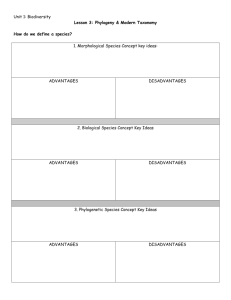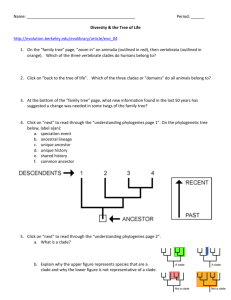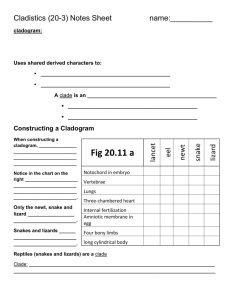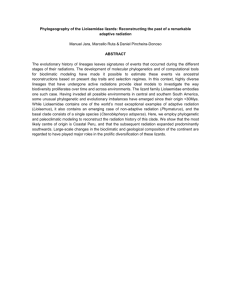SUPPLEMENTARY MATERIAL
advertisement
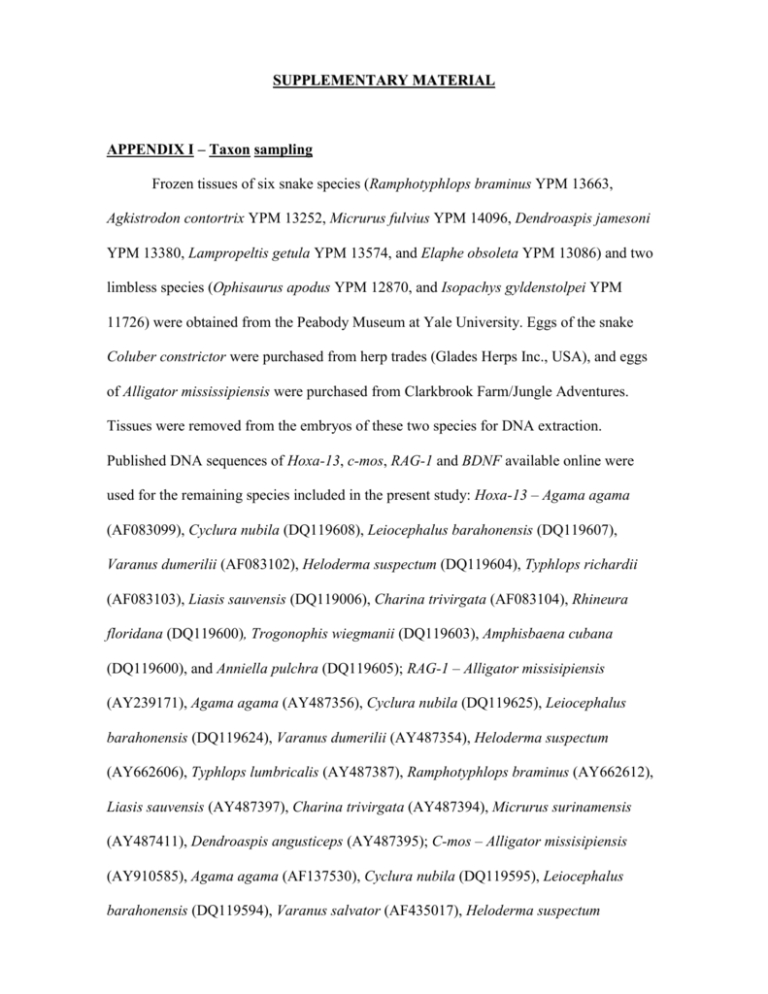
SUPPLEMENTARY MATERIAL APPENDIX I – Taxon sampling Frozen tissues of six snake species (Ramphotyphlops braminus YPM 13663, Agkistrodon contortrix YPM 13252, Micrurus fulvius YPM 14096, Dendroaspis jamesoni YPM 13380, Lampropeltis getula YPM 13574, and Elaphe obsoleta YPM 13086) and two limbless species (Ophisaurus apodus YPM 12870, and Isopachys gyldenstolpei YPM 11726) were obtained from the Peabody Museum at Yale University. Eggs of the snake Coluber constrictor were purchased from herp trades (Glades Herps Inc., USA), and eggs of Alligator mississipiensis were purchased from Clarkbrook Farm/Jungle Adventures. Tissues were removed from the embryos of these two species for DNA extraction. Published DNA sequences of Hoxa-13, c-mos, RAG-1 and BDNF available online were used for the remaining species included in the present study: Hoxa-13 – Agama agama (AF083099), Cyclura nubila (DQ119608), Leiocephalus barahonensis (DQ119607), Varanus dumerilii (AF083102), Heloderma suspectum (DQ119604), Typhlops richardii (AF083103), Liasis sauvensis (DQ119006), Charina trivirgata (AF083104), Rhineura floridana (DQ119600), Trogonophis wiegmanii (DQ119603), Amphisbaena cubana (DQ119600), and Anniella pulchra (DQ119605); RAG-1 – Alligator missisipiensis (AY239171), Agama agama (AY487356), Cyclura nubila (DQ119625), Leiocephalus barahonensis (DQ119624), Varanus dumerilii (AY487354), Heloderma suspectum (AY662606), Typhlops lumbricalis (AY487387), Ramphotyphlops braminus (AY662612), Liasis sauvensis (AY487397), Charina trivirgata (AY487394), Micrurus surinamensis (AY487411), Dendroaspis angusticeps (AY487395); C-mos – Alligator missisipiensis (AY910585), Agama agama (AF137530), Cyclura nubila (DQ119595), Leiocephalus barahonensis (DQ119594), Varanus salvator (AF435017), Heloderma suspectum (AY662566), Typhlops brachycephalus (AY099981), Rhamphotyphlops braminus (AY099980), Liasis sauvensis (AF544726), Charina trivirgata (AY099974), Agkistrodon piscivorus (AF471096), Micrurus fulvius (AY058935), Dendroaspis anguisticeps (AF544735), Coluber constrictor priapus (AY486937), Elaphe quatuorlineata (AY486955); BDNF – Alligator missisipiensis (AF416631), Japalura splendida (AF497713), Leiocephalus carinatus (AY987970), Polychrus marmoratus (AY987966), Brachylophus fasciatus (AY987980), Rhamphotyphlops sp. (AY988043), Charina bottae (AY988042), Morelia spilota (AY988035), Acrochordus javanicus (AY988036), Cylindrophis ruffus (AY988037), Exiliboa placata (AY988034). For the analysis of Hoxa-13 along Gnathostomata, data was obtained also from tissues obtained for Gymnopis multiplicata (Museum of Vertebrate Zoology, UC Berkeley, MVZ228795), Protopterus annectens (tissue donated from a pet owner), Geochelone nigra (tissue donated by Dr. G. Caccone, EEB-Yale University), and published sequences available online for the following species: Heterodontus francisci (AF479755), Polyodon spathula (AY661749), Polypterus senegalus (‘Bichir’, obtained from BAC genomic library, Chiu et al. 2004), Latimeria chalumnae (AC147788), Ambystoma mexicanum (U20942), Gallus gallus (AY030050). APPENDIX II - Phylogenetic Analysis for Squamata Public sequences of mitochondrial genomes available online were downloaded from GenBank for the following taxa: Amphisbaena schmidti (AY605475.1), Geocalamus acutus (AY605476.1), Bipes biporus (AY605480.1), Bipes canaliculatus (AY605482.1), Bipes tridactylus (AY605477.1), Diplometopon zarudnyi (AY605474.1), Gecko gecko (AY282753.1), Teratoscincus keyserlingii (AY753545.1), Iguana iguana (AJ278511.2), Sceloporus occidentalis (AB079242.1), Cordylus warreni (AB079613.1), Eumeces egregius (AB016606.1), Varanus komodoensis (AB080275.1 and AB080276.1), Shinisaurus crocodilurus (AB080274.1), Abronia graminea (AB080273.1), Boa constrictor (AB177354.1), Python regius (AB177878.1), Acrochordus granulatus (AB177879.1), Cylindrophis ruffus (AB179619.1), Leptotyphlops dulcis (AB079597.1), Ovophis okinavensis (AB175670.1), Xenopeltis unicolor (AB179620.1), Sphenodon punctatus (AF534390.1), Alligator mississippiensis (Y13113.1), Gallus gallus (X52392.1), and Casuarius casuarius (AF338713.2). All sequences were aligned using the Clustal-V algorithm (Higgins et al. 1992), implemented by the software MegAlign 3.15 (DNASTAR). Indels were manually removed and the alignment was manually inspected to identify regions that were ambiguously aligned by MegAlign; these regions were also removed. All characters were equally weighted. Phylogenetic analyses were performed using maximum parsimony (MP) and maximum likelihood (ML) in PAUP* version 4.0b10 (Swofford 2003), and Bayesian inference (BPP) in MrBayes version 3.0b4 (Ronquist and Huelsenbeck 2003). Phylogenetic inference was performed with the concatenated data set of 10,683bp. Models of evolution were estimated by MrModeltest 2.1 (Nylander 2004). A single model was estimated for the concatenated dataset for ML (HKY85 model). In the Bayesian analyses, the model used was GTR+I+G, but the data was partitioned into 1st, 2nd and 3rd codon positions with each partition having its own GTR+I+G parameters, estimated in MrBayes from the data using default priors. Statistical confidence in nodes was evaluated using 10,000 bootstrap replicates for MP (Felsenstein 1985; Hillis and Bull 1993) and 100 bootstrap replicates for ML (due to computational constraints). For ML and MP analyses we set the maxtrees command in PAUP* to 5,000 with automatic increase every time the maximum of number of trees was reached, followed by a heuristic search with TBR branch swapping. Heuristic searches were unrooted and consensus trees were visualized with TreeView (Page 1996). In the Bayesian phylogenetic inference, five chains of 1,000,000 generations were conducted, sampling every 1,000th tree. The parameters of each run were visually inspected with Tracer version 1.0.1 (Rambaut and Drummond 2003) to determine the number of generations until stationary trees; the first 100 trees were discarded. All parameters were linked between gene datasets in Bayesian analyses, but gamma and number of invariable sites were estimated for each gene individually. The phylogenetic tree generated by the Bayesian inferences (Fig. 1 of Appendix II; bootstrap values from ML and MP heuristic searches are mapped on to nodes with support values greater than 50%) was strongly supported by values of posterior probabilities higher than 0.97, and the topology obtained was congruent among the three methods applied (Maximum Parsimony, Maximum Likelihood and Bayesian inferences). In the phylogenetic hypothesis generated by data from mitochondrial genomes, Serpentes are sister clade of amphisbaenids, and this whole clade (snakes plus amphisbaenids) occupies a sister position of a clade including iguanids and anguimorphs (Fig. 1 of Appendix II). Gekkonids are placed in a basal position within squamates, with Sphenodon and the clade grouping Alligator and birds placed in the most ancestral positions in the phylogenetic trees (Fig. 1 of Appendix II), as they were determined a priori as outgroups in the analyses. The phylogenetic hypothesis obtained in this study using molecular data from mitochondrial genomes agrees with some aspects of topologies proposed from molecular data (Vidal and Hedges 2005; Fry et al. 2006; Wiens et al. 2006) by placing a clade composed by iguanids and anguimorphs as a sister group of the clade that contains snakes, but disagrees with Townsend et al. (2004), which assumed Serpentes as a sister clade of Anguimorpha, Iguanidae as a sister clade of this group (Serpentes + Anguimorpha), and amphisbaenids placed in a separate group of Serpentes. It also disagrees with some phylogenetic studies based on morphological data that placed iguanids in basal positions in the topologies (e.g. Caldwell 1999; Lee 2000), although some few studies using morphological characters also place iguanids and anguimorphs closer to each other, as a separate group from the clade including snakes (e.g. Caprette et al. 2004 using eye anatomy). Literature Cited (Appendix II) Caldwell MW (1999) Squamate phylogeny and the relationships of snakes and mosasauroids. Zool. J. Linn. Soc. 125:115-147. Carprette CL, Lee MSY, Shine R, Mokany A, Downhower JR (2004) The origin of snakes (Serpentes) as seen through eye anatomy. Biol. J. Linn. Soc. 81:469-482. Felsenstein J (1985) Phylogenies and the comparative method. Am. Nat. 125:1-15. Fry BG, Vidal N, Norman JA, Vonk FJ, Scheib H, Ramjan FR, Kuruppu S, Fung K, Hedges SB, Richardson MK, Hodgson WC, Ignjatovic V, Summerhayes R, Kochva E (2006) Early evolution of the venom system in lizards and snakes. Nature 439(7076): 584-588. Higgins DG, Bleasby AJ, Fuchs R (1992) CLUSTAL-V – Improved software for multiple sequence alignment. Comp. Appl. Biosci. 8:189-191. Hillis DM, Bull JJ (1993) An empirical test of bootstrapping as a method for assessing confidence in phylogenetic analysis. Syst. Biol. 42:182-192. Lee MS (2000) Soft anatomy, diffuse homoplasy, and the relationships of lizards and snakes. Zool. Scripta 29(2):101-130. Nylander JAA (2004) MrModeltest 2.1. Program distributed by the author. Evolutionary Biology Centre, Uppsala University. Page RD (1996) TREEVIEW: An application to display phylogenetic trees on personal computers. Comput. Appl. Biosci. 12:357-358. Rambaut A, Drummond A (2003) Tracer v1.0, available from evolve.zoo.ox.ac.uk. Ronquist F, Huelsenbeck JP (2003) MrBayes 3: Bayesian phylogenetic inference under mixed models. Bioinformatics 19:1572-1574. Swofford D (2003) PAUP*: Phylogenetic Analysis Using Parsimony (*and other methods), Version 4. Sinauer Associates. Townsend TM, Larson A, Louis E, Macey JR (2004) Molecular phylogenetics of Squamata: the position of Snakes, Amphisbaenians, and Dibamids, and the root of the Squamate tree. Syst. Biol. 53(5):735-757. Vidal N, Hedges BS (2005) The phylogeny of squamate reptiles (lizards, snakes, and amphisbaenians) inferred from nine nuclear protein-coding genes. C.R. Biologies 328:1000-1008. Wiens JJ, Brandley MC, Reeder TW (2006) Why does a trait evolve multiple times within a clade? Repeated evolution of snakelike body form in squamate reptiles. Evolution 60:123-141. Appendix II Alligator mississippiensis 1.00 Casuarius casuarius -/96 1.00 100/100 Gallus gallus Varanus komodoensis Abronia graminea 1.00 64/94 1.00 78/57 Shinisaurus crocodilurus Anguimorphs Sphenodon punctatus Cordylus cordylus -/76 0.97 90/94 0.97 Eumeces egregius Iguana iguana 58/82 1.00 100/100 Sceloporus occidentalis Iguanids 1.00 Reptilia Leptotyphlops dulcis 88/83 Boa constrictor 1.00 0.99 Ovophis okinavensis 100/100 -/- Cylindrophis ruffus 1.00 96/72 Python regius 1.00 96/81 1.00 99/99 1.00 Xenopeltis unicolor 87/58 Amphisbaena schmidti 1.00 100/100 1.00 -/72 1.00 85/100 1.00 Geocalamus acutus Bipes tridactylus 100/100 1.00 Bipes biporus 100/100 1.00 100/100 Bipes canaliculatus Gekko gecko 1.00 100/100 PP MP/ML Teratoscincus keyserlingii Amphisbaenias Diplometopon zarudnyi Squamata 1.00 100/100 Serpentes Acrochordus granulatus 1.00
